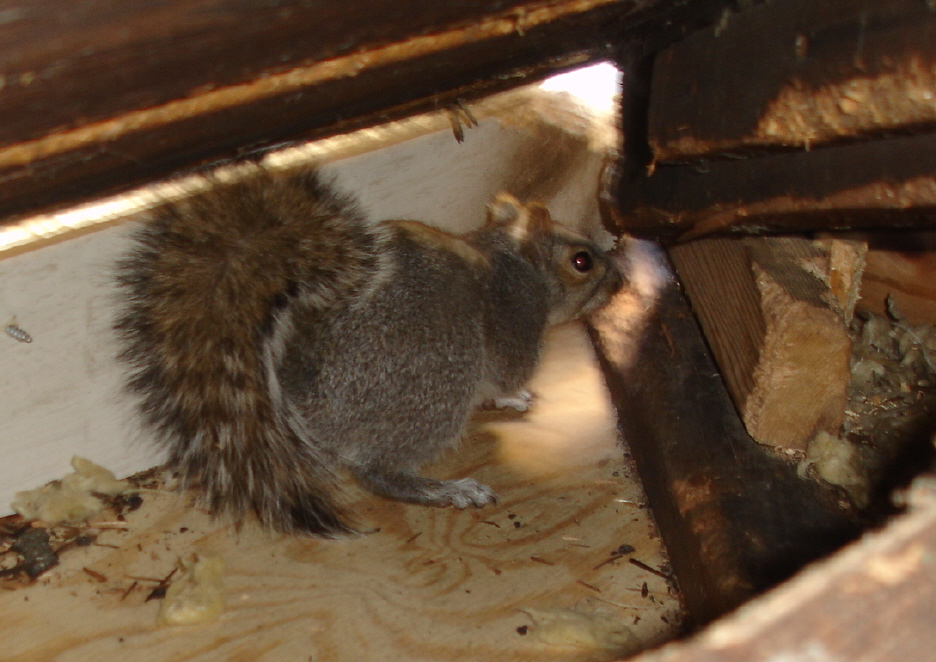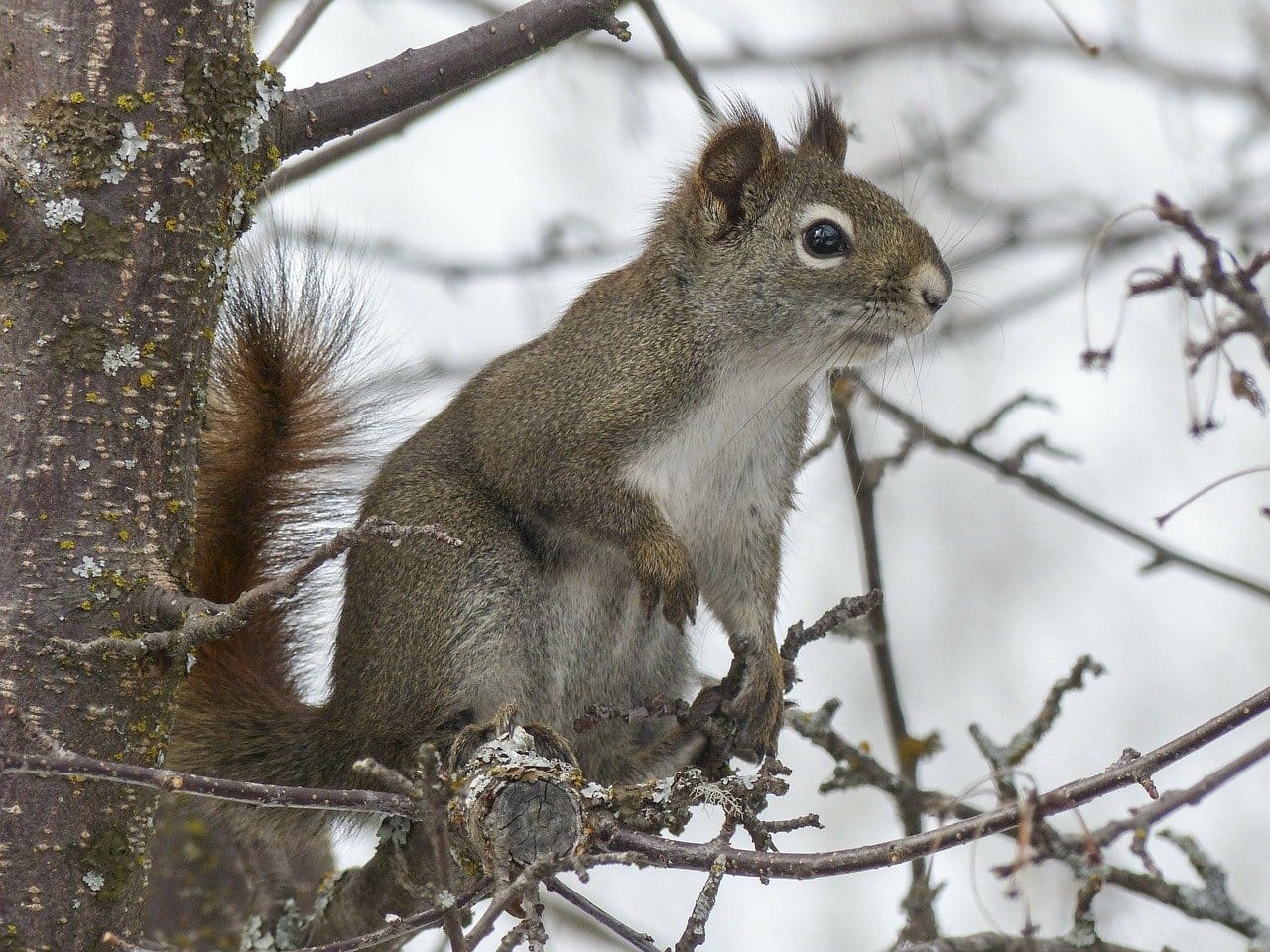Squirrels look for a place to call home, and although a good tree will usually suffice, when they gain access to an attic space they will move in and nest. Squirrels in your roof can cause damage, and if they are present they are an indication of a breach to the integrity of your home. When squirrels do nest in an attic, they can cause a variety of problems for the homeowner. They can damage insulation, using the material for nesting and that is why it is very important to call your local squirrel removal company in Toronto.
Like other rodents, squirrels will chew their way through wood and wiring which can create electrical problems that are potentially very dangerous. Having one of these critters take up residence in your roof carries other risk factors. The animal’s waste will accumulate, creating a health hazard, and whatever entrance they used to get into the attic is also an opening for rain and moisture to get in which could result in black mold growing and having serious effects on the health of your family. There are scent deterrents to get the squirrels to leave your attic, but if babies are involved this can be complicated. Squirrels can have two litters a year, in spring and in fall. Waiting for the height of summer is an easy way to deal with the situation, as the squirrels will likely leave because of the heat, and you can block their entrance to keep them from returning.
If you evict the adult squirrels before the babies are ready to leave the nest, they won’t survive on their own. When the squirrels are gone it’s important to close their entrance, otherwise a new critter will find its way in and make itself at home. Once this is all done, you must assess the extent of the damage done, and clean any waste material found. To ensure that a squirrel infestation is dealt with properly, in a humane way and to deter any other animals from finding their way into your home, it is a good idea to call a professional in wildlife removal.
How do you get squirrels out of your roof?
To keep squirrels off your roof, you need to prevent. Prevent them from climbing on the roof and make sure they stay away from it. To do this, there are two main methods.
First, especially if you live in a house with a garden and a lot of trees, you need to take care of the trees:
- Squirrels love to climb on bird feeders or fruit trees and, from there, easily jump on the roof of a house. To prevent this from happening, you need to cut tree branches near the roof of your home. Specifically, you have to leave at least 8 feet between the branches and the roof, this is because squirrels are excellent jumpers.
- Squirrels can also be prevented from climbing a tree by attaching a two-foot-wide sheet of metal about seven feet from the ground to block their passage.
Secondly, you need to take care of the roof. You must look for and seal all the holes that lead from the roof to the attic, replace any rotten wood (more easily chewable) and cover the vents or chimney on the roof with metal grates or a metal mesh. You can also try to spray repellent on the sealed openings, so as to remove the squirrels and habitats from not reaching the roof anymore, or, to be on the safe side, in case you have a fireplace, buy a steel cap for the chimney chimney to be installed on the chimney itself.
Can squirrels live in your roof?
Yes. Areas of a house such as the roof, attic or similar zones are suitable for squirrels for several reasons. As a result, these small rodents often tend to settle, nest and live permanently in similar areas of a home.
But why can squirrels live in your roof? Simple:
- Roofs, attics and soffits are ideal areas for squirrels’ nests because they are high enough to guarantee protection from predators and even from humans.
- A roof is also an area that remains warm and dry even if it rains a lot or is very cold, protecting small rodents from the weather. One of the first objectives of the squirrels, in fact, is to find a place where you can nest without risking because of the climate.
- Moreover, given all the wood of which a roof is made, not only can squirrels obtain material for nesting, but they can also small niches in which to position themselves and place their nests.
So not only can squirrels live in your roof, but it is also a perfect “home” for them, so they can stay safe and warm very easily.
How do I know if I have squirrels in my attic?
To find out if you have squirrels in the attic just take note of several indicators, which we will now indicate:
- Strange noises: The most common sounds that are heard if you have squirrels in the attic are three: running sounds, jumping and constantly scratching. Especially in the morning, when they are most active.
- Foul odors: Over time, squirrel urine gives off a terrible and very powerful smell that can easily penetrate the whole house through ventilation and walls. Moreover, speaking of ventilation, squirrels can get stuck inside them and die, giving off an even more terrible smell. If you start to feel unpleasant dori around the house and don’t know where they come from, it could be the fault of the squirrels.
- External Damage: Squirrels can sneak into the house even from the smallest holes. In this case, if there are external damages, even very small ones, such as holes or damages along the whole roof, it is possible that the squirrels got into the attic.
- Chewing marks and Internal Damage: An attic is full of wood, insulating and sometimes even electric cables. All materials that squirrels love to bite, chew and damage. The squirrels will begin to damage the wood (to enter, exit and create space), the insulation (to create their nests) and the cables (to control the growth of their teeth). All things that will damage your home even more.
- Excrement: Finally, one of the clearest clues are squirrel droppings. Very similar to those of bats, noticing stacks of excrement definitely means that you have an infestation of some kind. Experts can easily tell what kind of infestation it is.
- Squirrel Footprints: Recognizing the footprints of a squirrel is very simple: the forelegs have four toes and are slightly shorter than the hind legs, with five toes. If you often see these types of footprints around your home there could be a possible infestation.
Can squirrels chew through ceiling?
Obviously yes, as soon as they get a chance. And, indeed, not only these animals that do this, but all rodents. The strength of a squirrel’s teeth makes it capable of biting and chewing wood, plastic and even not too hard metal. Consequently, if squirrels want to enter a house, they will easily do it through the roof, biting and chewing.
An advantage of the squirrels is the fact that not only are they very small animals, but they can also enter very small spaces (often even getting stuck). As a result, they don’t even need to chew much through the roof to get into the house.
Especially in the event that they get stuck, the squirrels will start using their teeth and claws to free themselves and escape from where they are stuck or to free themselves and finally enter an attic. If a squirrel wants to get into your house, it won’t just stop at the ceiling.
The squirrels will chew, bite and scratch through all the materials in front of them (wooden beams, wooden panels, insulating material, plastic, metal, plasterboard etc.) to find a place to nest. If you noticed signs of squirrel invasion call our professional squirrel removal services in Toronto at 647-496-0815.
Article Updated, January 15, 2020

